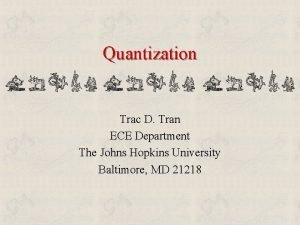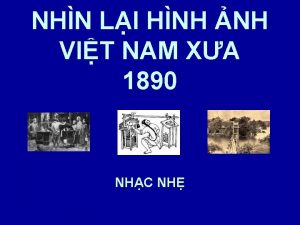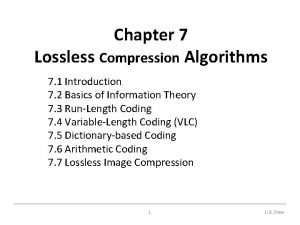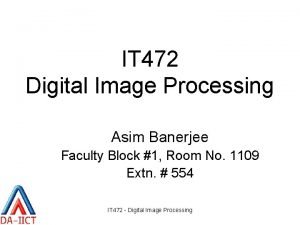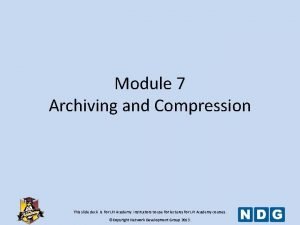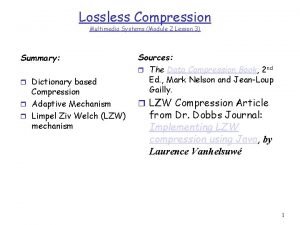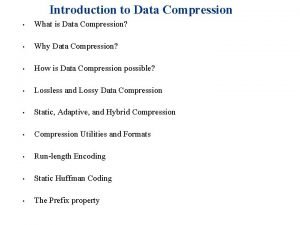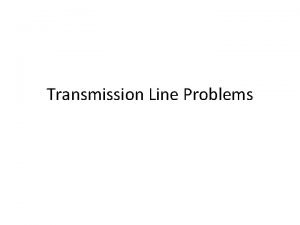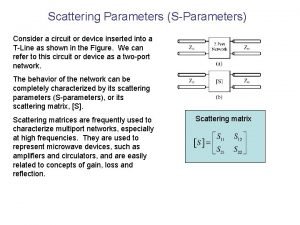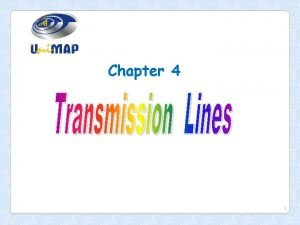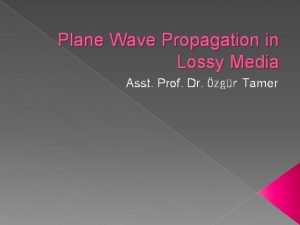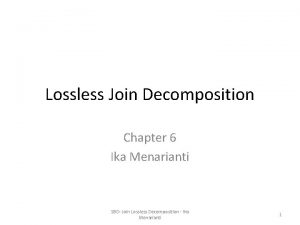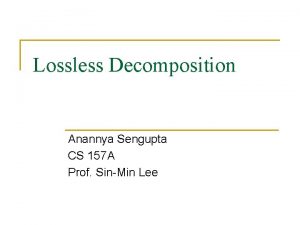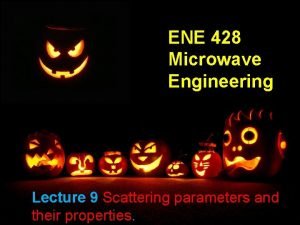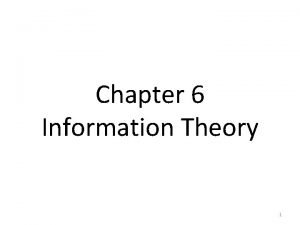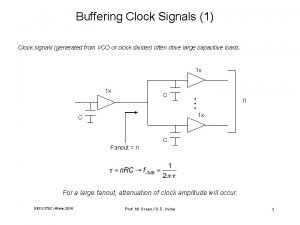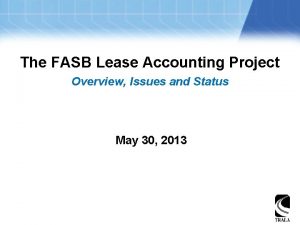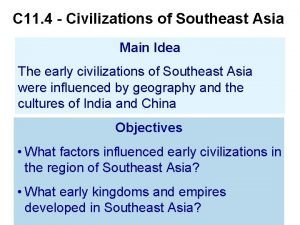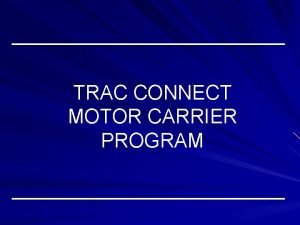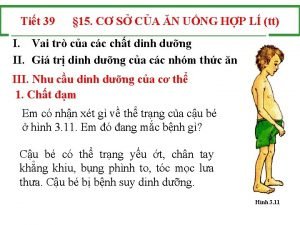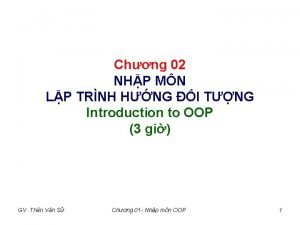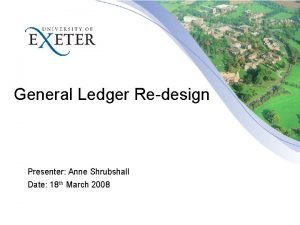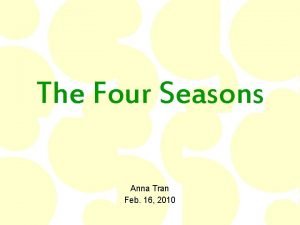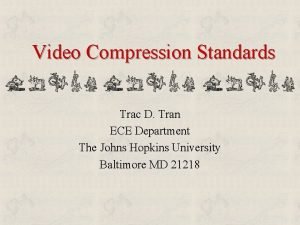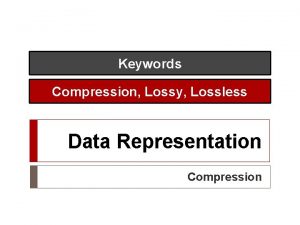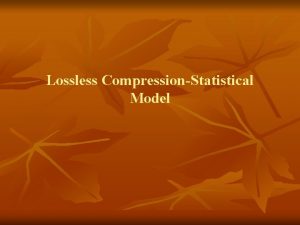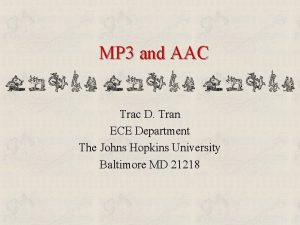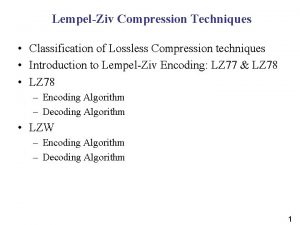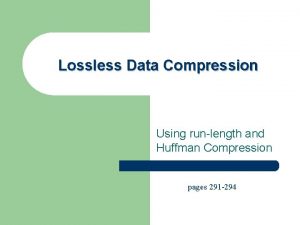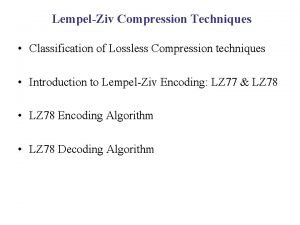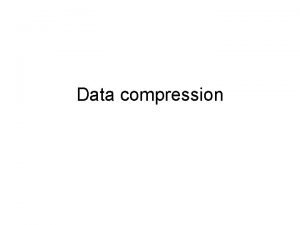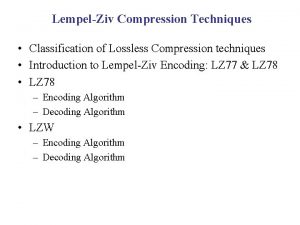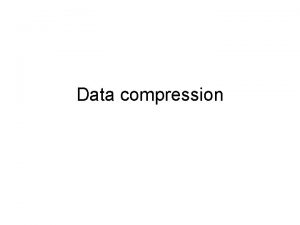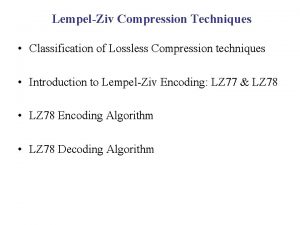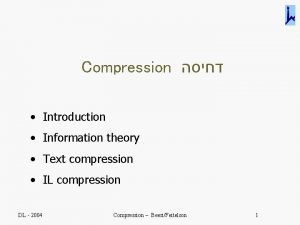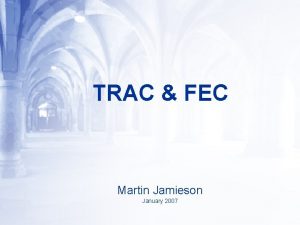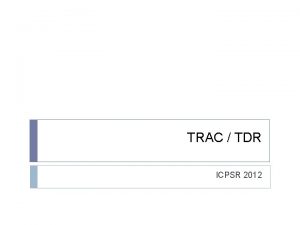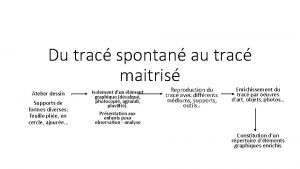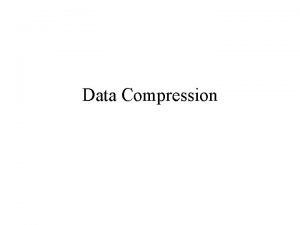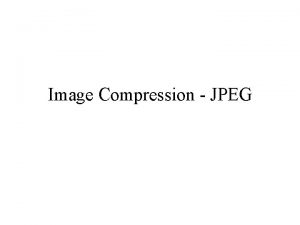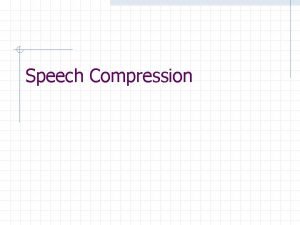Introduction to Lossless Compression Trac D Tran ECE






















![Huffman Code u Shannon-Fano code [1949] § Top-down algorithm: assigning code from most frequent Huffman Code u Shannon-Fano code [1949] § Top-down algorithm: assigning code from most frequent](https://slidetodoc.com/presentation_image_h/98a026f6e251b4efbf84a5b3de1c7886/image-23.jpg)










![Adaptive Arithmetic Coding u Three symbols {A, B, C}. Encode: BCCB… 1 P[C]=1/3 66% Adaptive Arithmetic Coding u Three symbols {A, B, C}. Encode: BCCB… 1 P[C]=1/3 66%](https://slidetodoc.com/presentation_image_h/98a026f6e251b4efbf84a5b3de1c7886/image-34.jpg)




- Slides: 38

Introduction to Lossless Compression Trac D. Tran ECE Department The Johns Hopkins University Baltimore, MD 21218

Outline u u Review of information theory Fixed-length codes § ASCII u Variable-length codes § § u Morse code Shannon-Fano code Huffman code Arithmetic code Run-length coding Dr. Claude Elwood Shannon

Information Theory u A measure of information § The amount of information in a signal might not equal to the amount of data it produces § The amount of information about an event is closely related to its probability of occurrence u Self-information § The information conveyed by an event A with probability of occurrence P[A] is 0 1

Information = Degree of Uncertainty u u u Zero information § The earth is a giant sphere § If an integer n is greater than two, then has no solutions in non-zero integers a, b, and c Little information § It will snow in Baltimore in February § JHU stays in the top 20 of US World & News Report’s Best Colleges within the next 5 years A lot of information § A Hopkins scientist shows a simple cure for all cancers § The recession will end tomorrow!

Two Extreme Cases tossing a fair coin source encoder channel source decoder P(X=H)=P(X=T)=1/2: (maximum uncertainty) Minimum (zero) redundancy, compression impossible tossing a coin with two identical sides head or tail? channel duplication HHHH… TTTT… P(X=H)=1, P(X=T)=0: (minimum redundancy) Maximum redundancy, compression trivial (1 bit is enough) Redundancy is the opposite of uncertainty

Weighted Self-information 0 1/2 1 0 1/2 0 As p evolves from 0 to 1, weighted self-information first increases and then decreases Question: Which value of p maximizes IA(p)?

Maximum of Weighted Self-information

Entropy u Entropy § Average amount of information of a source, more precisely, the average number of bits of information required to represent the symbols the source produces § For a source containing N independent symbols, its entropy is defined as § Unit of entropy: bits/symbol § C. E. Shannon, “A mathematical theory of communication, ” Bell Systems Technical Journal, 1948

Entropy Example u Find and plot the entropy of the binary code in which the probability of occurrence for the symbol 1 is p and for the symbol 0 is 1 -p H 1 0 1/2 1 p

Entropy Example u Find the entropy of a DNA sequence containing four equally-likely symbols {A, C, T, G} u P[A]=1/2; P[C]=1/4; P[T]=P[G]=1/8; H=? u So, how do we design codes to represent DNA sequences?

Conditional & Joint Probability Joint probability Conditional probability

Conditional Entropy u Definition u Main property u u What happens when X & Y are independent? What if Y is completely predictable from X?

Fixed-Length Codes u Properties § Use the same number of bits to represent all possible symbols produced by the source § Simplify the decoding process u Examples § American Standard Code for Information Interchange (ASCII) code § Bar codes § One used by the US Postal Service § Universal Product Code (UPC) on products in stores § Credit card codes

ASCII Code ASCII is used to encode and communicate alphanumeric characters for plain text u 128 common characters: lower-case and upper-case letters, numbers, punctuation marks… 7 bits per character u First 32 are control characters (for example, for printer control) u Since a byte is a common structured unit of computers, it is common to use 8 bits per character – there an additional 128 special symbols u Example Character u Dec. index Bin. code

ASCII Table

Variable-Length Codes u u Main problem with fixed-length codes: inefficiency Main properties of variable-length codes (VLC) § Use a different number of bits to represent each symbol § Allocate shorter-length code-words to symbols that occur more frequently § Allocate longer-length code-words to rarely-occurred symbols § More efficient representation; good for compression u Examples of VLC § § Morse code Shannon-Fano code Huffman code Arithmetic code

Morse Codes & Telegraphy u Morse codes u E ·� T - I · ·� M -- S · · ·� O --- H ··· ·� CH ---- A ·- N -· U ··- D -·· V ···- B -··· R ·-· K -·- W ·-- G --· L ·-·· Y -·-- P ·--· X -··- F ··-· Q --·- J ·--- C -·-· u u “What hath God wrought? ”, DC – Baltimore, 1844 Allocate shorter codes for more frequently-occurring letters & numbers Telegraph is a binary communication system – dash: 1; dot: 0

More on Morse Code

Issues in VLC Design u Optimal efficiency § How to perform optimal code-word allocation (in an efficiency standpoint) given a particular signal? u Uniquely decodable § No confusion allowed in the decoding process § Example: Morse code has a major problem! § Message: SOS. Morse code: 000111000 § Many possible decoded messages: SOS or VMS? u Instantaneously decipherable § Able to decipher as we go along without waiting for the entire message to arrive u Algorithmic issues § Systematic design? § Simple fast encoding and decoding algorithms?

VLC Example Symbol Prob. FLC Code 1 Code 2 Code 3 Code 4 A P[A]=1/2 000 1 1 0 00 B P[B]=1/4 001 01 10 10 01 C P[C]=1/8 010 001 100 110 10 D P[D]=1/16 011 0001 1000 1110 11 E P[E]=1/16 100 00001 10000 1111 110 Average Length H=30/16 3 31/16 30/16 33/16

VLC Example Symbol Prob. FLC Code 1 Code 2 Code 3 Code 4 A P[A]=1/2 000 1 1 0 00 B P[B]=1/4 001 01 10 10 01 C P[C]=1/8 010 001 100 110 10 D P[D]=1/16 011 0001 1000 1110 11 E P[E]=1/16 100 00001 10000 1111 110 Average Length H=30/16 3 31/16 30/16 33/16 u u u Uniquely decodable – Self-synchronizing: Code 1, 2, 3. No confusion in decoding Instantaneous: Code 1, 3. No need to look ahead. Prefix condition = uniquely decodable & instantaneous: no codeword is a prefix of another

Shannon-Fano Code u Algorithm § Line up symbols by decreasing probability of occurrence § Divide symbols into 2 groups so that both have similar combined probability § Assign 0 to 1 st group and 1 to the 2 nd Robert M. Fano § Repeat step 2 u Example Symbols A B C D E Prob. 0. 35 0. 17 0. 16 0. 15 H=2. 2328 bits/symbol Code-word 00 Average code-word length = 01 0. 35 x 2 + 0. 17 x 2 10 + 0. 16 x 3 + 0. 15 x 3 110 = 2. 31 bits/symbol 111
![Huffman Code u ShannonFano code 1949 Topdown algorithm assigning code from most frequent Huffman Code u Shannon-Fano code [1949] § Top-down algorithm: assigning code from most frequent](https://slidetodoc.com/presentation_image_h/98a026f6e251b4efbf84a5b3de1c7886/image-23.jpg)
Huffman Code u Shannon-Fano code [1949] § Top-down algorithm: assigning code from most frequent to least frequent § VLC, uniquely & instantaneously decodable (no code-word is a prefix of another) § Unfortunately not optimal in term of minimum redundancy u Huffman code [1952] § Quite similar to Shannon-Fano in VLC David A. Huffman concept § Bottom-up algorithm: assigning code from least frequent to most frequent § Minimum redundancy when probabilities of occurrence are powers-of-two § In JPEG images, DVD movies, MP 3 music

Huffman Coding Algorithm u Encoding algorithm § Order the symbols by decreasing probabilities § Starting from the bottom, assign 0 to the least probable symbol and 1 to the next least probable § Combine the two least probable symbols into one composite symbol Root § Reorder the list with the composite symbol § Repeat Step 2 until only two symbols remain in the list u Huffman tree § Nodes: symbols or composite symbols § Branches: from each node, 0 defines one branch while 1 defines the other u Decoding algorithm § Start at the root, follow the branches based on the bits received § When a leaf is reached, a symbol has just been decoded 1 1 Leaves Node 0 0

Huffman Coding Example Symbols A B C D E Prob. 0. 35 0. 17 0. 16 1 0. 15 0 Huffman Codes A 0 B 111 C 110 D 101 E 100 Symbols A DE B C Prob. 0. 35 0. 31 0. 17 0 Huffman Tree 1 0 BCDE A 0 DE BC 1 B 1 0 E Symbols A BC DE Prob. 0. 35 0. 34 1 0. 31 0 Symbols Prob. BCDE 0. 65 1 A 0. 35 0 C D Average code-word length = E[L] = 0. 35 x 1 + 0. 65 x 3 = 2. 30 bits/symbol

Huffman Coding Example Symbols A B C D E Prob. 1/2 1/4 1/8 1/16 0 1/16 1 Huffman Codes A 0 B 10 C 110 D 1110 E 1111 Symbols A B C DE Prob. 1/2 1/4 1/8 0 1/8 1 Huffman Tree 1 0 BCDE A 1 0 CDE B 1 0 DE C 1 0 D E Symbols A B CDE Prob. 1/2 1/4 0 1/4 1 Symbols Prob. A 1/2 0 BCDE 1/2 1 Average code-word length = E[L] = 0. 5 x 1 + 0. 25 x 2 + 0. 125 x 3 + 0. 125 x 4 = 1. 875 bits/symbol = H

Huffman Shortcomings u u Difficult to make adaptive to data changes Only optimal when Best achievable bit-rate = 1 bit/symbol Question: What happens if we only have 2 symbols to deal with? A binary source with skewed statistics? § Example: P[0]=0. 9375; P[1]=0. 0625. H = 0. 3373 bits/symbol. Huffman: E[L] = 1. § One solution: combining symbols!

Extended Huffman Code Symbols Prob. AA 225/256 AB 15/256 BA 15/256 BB 1/256 H=0. 6746 bits/symbol Symbols Prob. A=0 15/16 B=1 1/16 H=0. 3373 bits/symbol Huffman Tree 1 0 AA 1 0 AB 1 0 BB BA u u Larger grouping yield better performance Problems § Storage for codes § Inefficient & time-consuming § Still not well-adaptive Average code-word length = E[L] = 1 x 225/256 + 2 x 15/256 + 3 x 1/256 = 1. 1836 bits/symbol >> 2

Arithmetic Coding: Main Idea u u u Peter Elias in Robert Fano’s class! Large grouping improves coding performance; however, we do not want to generate codes for all possible sequences Wish list § a tag (unique identifier) is generated for the sequence to be encoded § easy to adapt to statistic collected so far § more efficient than Huffman u u Peter Elias Main Idea: tag the sequence to be encoded with a number in the unit interval [0, 1) and send that number to the decoder Review: binary representation of fractions § §

Coding Example Symbol X 1 X 2 X 3 Probability 0. 05 0. 2 0. 1 Huffman Code 10101 01 100 X 4 X 5 X 6 X 7 0. 05 0. 3 0. 2 0. 1 10100 11 00 1011 String to encode: X 2 X 3 X 6 X 5 X 7 Huffman: 01 01 100 00 11 1011 18 bits

Arithmetic Encoding Process 1 0. 90 X 7 X 6 0. 70 0. 25 0. 1 0. 074 0. 07136 0. 071336 X 7 X 6 X 5 0. 40 X 4 0. 35 X 3 0. 25 X 2 0. 05 X 1 0 X 6 X 5 X 3 X 5 X 4 X 3 X 2 0. 05 0. 06 0. 070 0. 0710 String to encode: X 2 X 3 X 6 X 5 0. 07128 0. 071312 Sym Prob X 7 range = high – low new_high = low + range x subinterval_high new_low = low+range x subinterval_low Final interval = [0. 0713336, 0. 0713360) Send to decoder: 0. 07133483886719 0. 0713360 X 7 16 bits X 1 0. 0713336 Huffman X 1 0. 05 10101 X 2 01 X 3 0. 1 100 X 4 0. 05 10100 X 5 0. 3 11 X 6 0. 2 00 X 7 0. 1 1011

Arithmetic Decoding Process u u low=0; high=1; range=high – low REPEAT § Find index i such that § § u OUTPUT SYMBOL high = low + range x subinterval_high low = low + range x subinterval_low range = high – low UNTIL END UPDATE

Arithmetic Decoding Example 1 0. 90 X 7 X 6 0. 70 0. 25 0. 1 0. 074 0. 07136 0. 071336 X 7 X 6 X 5 0. 40 X 4 0. 35 X 3 0. 25 X 2 0. 05 X 1 0 X 6 X 5 X 3 0. 06 X 3 0. 070 X 5 X 4 X 3 X 2 0. 05 0. 0713360 X 7 0. 0710 0. 07128 0. 071312 X 1 0. 0713336
![Adaptive Arithmetic Coding u Three symbols A B C Encode BCCB 1 PC13 66 Adaptive Arithmetic Coding u Three symbols {A, B, C}. Encode: BCCB… 1 P[C]=1/3 66%](https://slidetodoc.com/presentation_image_h/98a026f6e251b4efbf84a5b3de1c7886/image-34.jpg)
Adaptive Arithmetic Coding u Three symbols {A, B, C}. Encode: BCCB… 1 P[C]=1/3 66% 0. 666 75% 33% P[A]=1/3 0 P[C]=1/4 P[B]=1/2 P[B]=1/3 25% 0. 666 P[C]=2/5 A B P[C]=1/2 60% P[B]=2/5 P[A]=1/4 20% 0. 333 0. 666 P[A]=1/5 0. 5834 Final interval = [0. 6390, 0. 6501) 50% P[B]=1/3 16% P[A]=1/6 0. 6334 Decode? C

Arithmetic Coding: Notes u u u Arithmetic coding approaches entropy! Near-optimal: finite-precision arithmetic, a whole number of bits or bytes must be sent Implementation issues: § Incremental output: should not wait until the end of the compressed bit-stream; prefer incremental transmission scheme § Prefer integer implementations by appropriate scaling

Run-Length Coding u Main idea § Encoding long runs of a single symbol by the length of the run u Properties § A lossless coding scheme § Our first attempt at inter-symbol coding § Really effective with transform-based coding since the transform usually produces long runs of insignificant coefficients § Run-length coding can be combined with other entropy coding techniques (for example, run-length and Huffman coding in JPEG)

Run-Length Coding u Example: How do we encode the following string? u Run-length coding: (run-length, size) binary amplitude value number of consecutive zeros before current non-zero symbol actual value of the non-zero symbol in binary number of bits needed to encode this non-zero symbol (0, 4) 14 (2, 3) 5 (1, 2) -3 (5, 1) 1 (14, 1) -1 (0, 0)

Run-Length Coding (run-length, size) binary value always 1, no need to encode sign bit 0: positive 1: negative MSB … LSB (0, 4) 14 (2, 3) 5 (1, 2) -3 (5, 1) 1 (14, 1) -1 (0, 0) Huffman or arithmetic coding raw binary 4 000 3 01 2 00 1 0 -1 1 -2 10 -3 11 -4 100
 Trac tran
Trac tran Trac tran jhu
Trac tran jhu Md trần trác
Md trần trác Giám khảo trần sĩ trác
Giám khảo trần sĩ trác What is data compression in multimedia
What is data compression in multimedia Lossless compression algorithms in multimedia
Lossless compression algorithms in multimedia Lossless compression in digital image processing
Lossless compression in digital image processing Subjective fidelity criteria in digital image processing
Subjective fidelity criteria in digital image processing Lossy and lossless compression
Lossy and lossless compression Lossless compression
Lossless compression Lossless compression in multimedia
Lossless compression in multimedia Definition of data compression
Definition of data compression Lossless transmission line examples
Lossless transmission line examples Lossless network s-parameters
Lossless network s-parameters Transmission line
Transmission line Intrinsic impedance of lossy dielectric medium
Intrinsic impedance of lossy dielectric medium Lossless join decomposition adalah
Lossless join decomposition adalah Lossless join
Lossless join Lossless network s parameters
Lossless network s parameters Discrete memoryless channel
Discrete memoryless channel Decomposition in dbms ppt
Decomposition in dbms ppt Winters shunt
Winters shunt Masstrac
Masstrac Fas 13 straight line rent
Fas 13 straight line rent Split trac lease
Split trac lease Se asia rivers
Se asia rivers Master develop feature
Master develop feature Trac leases asc 842
Trac leases asc 842 Dcli chassis rates
Dcli chassis rates Câu hỏi trắc nghiệm về bệnh béo phì
Câu hỏi trắc nghiệm về bệnh béo phì Trắc nghiệm oop
Trắc nghiệm oop Usps trac
Usps trac Trac leases asc 842
Trac leases asc 842 Tutortrac gatech
Tutortrac gatech Tele trac
Tele trac Trac ledger
Trac ledger Ku credtran
Ku credtran Anna tran md
Anna tran md Người nằm xuống giã từ trần gian
Người nằm xuống giã từ trần gian

